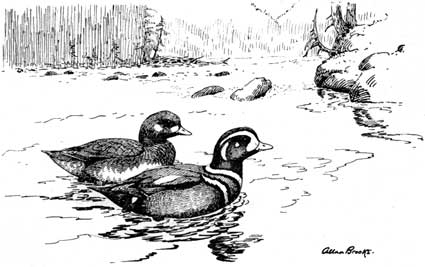|
Animal Life in the Yosemite
|

|
|
THE BIRDS HARLEQUIN DUCK. Histrionicus histrionicus (Linnaeus) Field characters.—Size, smaller than Mallard; bill small for a duck's; general coloration very dark. Male: Dark slate blue, strikingly marked with white patches on head, body and wings, and white ring around neck; flanks chestnut. Female: Dull dark brown with two white patches on each side of head—one on cheek, and one on ear region. (See fig. 37.) Occurrence.—Infrequent summer visitant to the larger streams of the Transition Zone. Adults and young seen on Merced River in Yosemite Valley near Sentinel Bridge.
At dusk on several evenings in late April, 1916, a small dark-colored duck was seen to fly up the Merced River in the vicinity of Sentinel Bridge, Yosemite Valley, and then to begin diving and drifting down-stream. On May 7 of the same year, this or another duck of the same species, which was unquestionably the Harlequin, was seen on the river with four ducklings about four days old. In 1920, Mr. C. W. Michael (MS) saw a pair in the same place on May 11 and 26, and June 4, and he saw a lone female on July 28. These are the only actual occurrences of this species in the area included in our field studies, recorded to the end of 1920. But the Harlequin Duck has several times been recorded as breeding along swift-flowing streams on the west flank of the Sierra Nevada at localities in the Transition Zone immediately to the north of Yosemite Park. It is reasonable to expect that a careful watch in early summer will bring to notice other instances of the nesting of this remarkable bird within the Park itself. So far, very little is known of its summer habits. The Harlequin Duck, strange to say, belongs to the class of sea ducks, and spends the winter exclusively along the roughest, surf-beaten ocean shores, such as, for instance, those around Point Reyes. Curiously, the birds have never been observed at any point between their mountain and seacoast haunts. |
| <<< PREVIOUS | CONTENTS | NEXT >>> |
Animal Life in the Yosemite ©1924, University of California Press Museum of Vertebrate Zoology grinnell/birds14.htm — 19-Jan-2006 | ||
